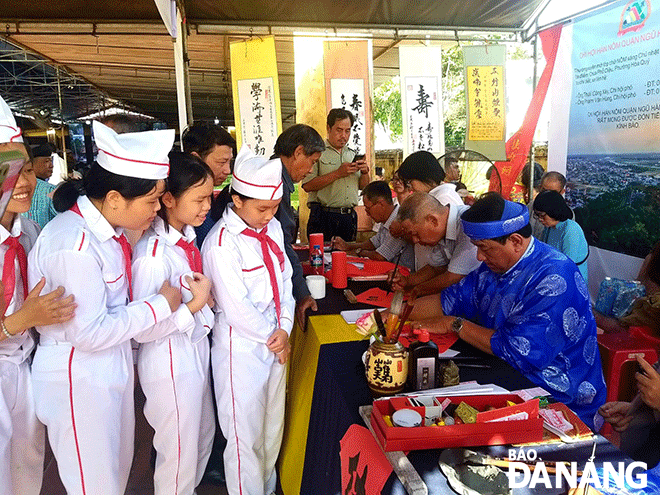Reviving Sino-Vietnamese characters contributes to preservation of national soul
The foundation of culture is language. Speaking, writing and reading are integral to everyday life, where language is the primary tool for expression and communication. Han-Nom or Sino-Vietnamese characters which are Viet Nam’s thousand-year-old scripts have become an important part of the nation's soul, and showcased the quintessence of Vietnamese culture.
Nom characters contained in the Sino-Vietnamese words that are quite unique in that they show obvious evidence of the ancient sesqui-syllabisity of Vietnamese. The script was widely used between the 15th and 19th centuries. Zenei art is inspired by the beauty, heritage and emotion of Nom characters.
In 1945, Viet Nam shifted to its current phonetic script based on the Latin alphabet. Except for scholars, few Vietnamese can still read Nom. Nom was on the edge of extinction, and contemporary Vietnamese have faced losing touch with much of the nation’s past that is preserved in the archives written in Nom.
 |
| The calligraphy booth run by Ngu Hanh Son District Chapter of the Da Nang Han Nom Association in a bid to reshape the culture of letter writing at the Quan The Am (Avalokitesvara) Festival 2023, and it was very attractive to young people. Photo: DOAN HAO LUONG |
Since the beginning of the 20th century, Sino-Vietnamese words have been no longer widely used in the nation. In their efforts to retrieve national traditions as well as preserve and promote quintessence of the progressive Vietnamese culture imbued with national identity with a focus on preserving the vast intellectual treasures left by their ancestors, many young people in Da Nang have chosen to study in-depth the ancient script.
Falling in love with studying Sino-Vietnamese characters
Mr. Le Van Phuc, 29, studied Bachelor's degree in cultural management and he now works at the Museum of Da Nang but he is passionate about studying Sino-Vietnamese characters. He has been interested in studying Nom characters since he was a student, but at that time he had no opportunity to study in depth this script. After graduation from university, he has worked as a heritage manager at the Museum of Da Nang. Therefore, he has the opportunity to study Sino-Vietnamese characters through the museum’s historical documents. Since then, he has understood the importance of the script to his job.
“Sino-Vietnamese words are very interesting if people understand them. They will also help us understand more the meanings of words we use everyday. Nom characters are not often seen in Vietnamese movies, so if you want to study in depth this script and stick with it for the long term, learners must really love it and study it every day," added Le. Van Phuc.
Meanwhile, Ms. Huynh Doan Vy , a resident of Nai Hien Dong ward, Son Tra District, has been interested in studying Sino-Vietnamese words after she came to the art of Vietnamese calligraphy. She has known calligraphy since 2015 but she has started to practice calligraphy since November 2022. Currently, she is opening calligraphy classes for people at all ages, including children, in order to help them to improve their handwriting.
Facilitating easy access to Sino-Vietnamese characters among young people
Da Nang is the first city in Viet Nam to establish a Han Nom Association at centrally-governed city-level. The Da Nang Han Nom Association was established in March 2022 following the decision issued by the Chairman of the municipal People's Committee. It now has 104 members and 30% of whom are young people. Han Nom clubs under the Da Nang Han Nom Center of the municipal Study Encouragement Association have already transformed into branches of the Da Nang Han Nom Association. Included are Han Nom chapters in Hai Chau, Son Tra, and Ngu Hanh Son districts, thereby, attracting more young people to study this script.
In particular, every Sunday morning, these branches offer free courses on Sino-Vietnamese characters and calligraphy.
In order to help young people have the opportunity to learn Sino-Vietnamese characters, the Ngu Hanh Son District chapter has run a calligraphy booth to reshape the culture of letter writing at the Quan The Am (Avalokitesvara) Festival, as well as participate in calligraphy performances at the Cau An (Praying for peace) Festival, at the Qua Giang Village Communal House.
Mr. Huynh Phuong Ba, the Honorary President of the Da Nang Han Nom Association highlighted the importance of learning the ancient script as the range of 70-80% of the vocabulary in modern Vietnamese comes from Sino-Vietnamese words. Therefore, learning this script will help us, including young people, understand more about the historical documents and books passed down by our ancestors.
Especially for young people, they can understand more about Vietnamese history when visiting pagodas, temples, epitaphs, and other sites across the country as they are able to read the early script carved in these sites. However, in order to help young people learn this script better, the seniors should spend more time imparting experiences to their grandchildren in learning it.
It can be seen that, in recent years, the early script and calligraphy learning has been promoted across the city with boom in number of Han Nom and calligraphy clubs in urban and rural areas, attracting many young people to join. Learning the words of our ancestors not only helps us absorb our culture, but also helps to cultivate positive behaviors and values that promote growth and flourishing, including calmness, good manners and carefulness.
Promotion of the early script learning is a great way to preserve the types of scripts which have existed for a long time in Viet Nam’s glorious history.
Reporting by DOAN HAO LUONG – Reporting by H.L